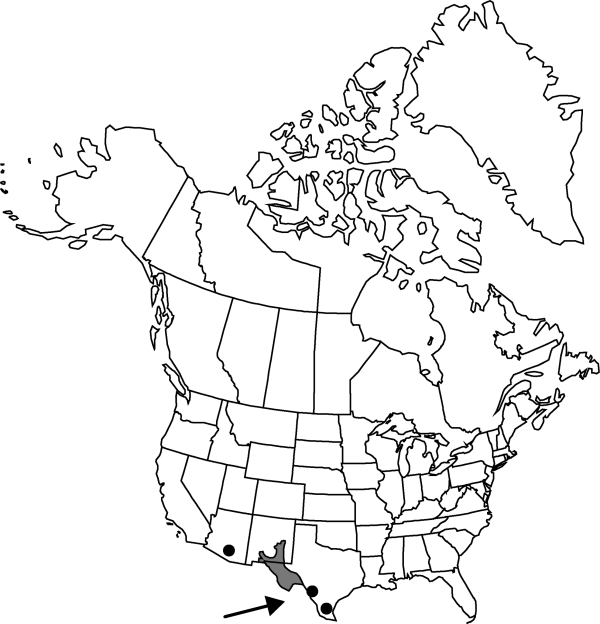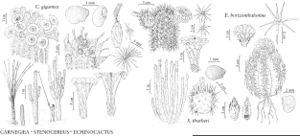Difference between revisions of "Echinocactus horizonthalonius"
Cact. Gen. Sp. Nov., 19. 1839.
imported>Volume Importer |
imported>Volume Importer |
||
| Line 55: | Line 55: | ||
|publication year=1839 | |publication year=1839 | ||
|special status=Illustrated | |special status=Illustrated | ||
| − | |source xml=https:// | + | |source xml=https://bitbucket.org/aafc-mbb/fna-data-curation/src/2e0870ddd59836b60bcf96646a41e87ea5a5943a/coarse_grained_fna_xml/V4/V4_354.xml |
|subfamily=Cactaceae subfam. Cactoideae | |subfamily=Cactaceae subfam. Cactoideae | ||
|genus=Echinocactus | |genus=Echinocactus | ||
Latest revision as of 21:58, 5 November 2020
Plants normally unbranched. Stems pale gray-green to bright gray-blue, flat-topped or hemispheric and deep-seated in sub-strate, spheric with age or stoutly short cylindric (remaining hemispheric at high elevations), 4–25(–45) × 8–15(–20) cm; ribs (7–)8(–9), vertical to helically curving around stem, rib crests broadly rounded, uninterrupted or slightly constricted between areoles. Spines (5–)8(–10) per areole, loosely projecting or strongly decurved, pink, gray, tan, or brown, strongly annulate-ridged, subulate, ± flattened, glabrous, generally not hiding stem surface; radial spines 5(–8) per areole, similar to central spines; central spines 1(–3) per areole, 18–43 × 1–2.5(–3) mm, longest spine usually descending, straight or decurved throughout its length. Flowers 5–7 × 5–6.5(–9.5) cm; inner tepals bright rose-pink or magenta, color ± uniform from base to apex, 3 × 1.5 cm, margins entire to serrate; stigma lobes pinkish to olive. Fruits indehiscent or weakly dehiscent through basal abscission pore, pink or red, spheric to ovoid-cylindric, surfaces partly or entirely hidden by hairs from axils of scales and long areolar hairs of stem apex, usually quickly drying to tan shell before seed dispersal, 10–30 mm; scales several, tips dark, spinelike, glabrous. Seeds black or gray, angular or slightly wrinkled, spheric to obovoid, 2–3 mm; testa cell surfaces slightly convex, with weak network pattern of slightly protruding anticlinal cell walls. 2n = 22.
Phenology: Flowering Apr–Sep.
Habitat: Arid rocky slopes, primarily limestone
Elevation: 600-1700(-2500) m
Distribution

Ariz., N.Mex., Tex., Mexico.
Discussion
The Sonoran Desert populations of Echinocactus horizonthalonius have been segregated as var. nicholii, but are relatively similar to plants in New Mexico and extreme western Texas. Much greater morphologic diversity exists farther east and in Mexico, where shorter-spined, nearly flat-topped plants, which are more distinctive than the Sonoran Desert populations, have escaped taxonomic distinction.
Selected References
None.
